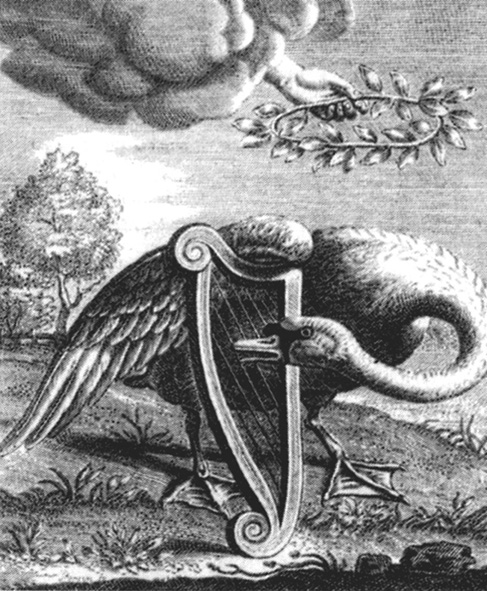
Figure 1. The swan was seen as the most musical of birds associated with the god Apollo, god of music and poetry, with Orpheus, the first mortal poet, and also with the Muses, the nymphs that inspire divine inspiration in mortal kind.

Figure
1. The swan was seen as the most musical of birds associated with the god Apollo,
god of music and poetry, with Orpheus, the first mortal poet, and also with the
Muses, the nymphs that inspire divine inspiration in mortal kind.
Soul of the World:
The Sweet Swans of Maeonia
A Prelude to The Cygnus Key: The Denisovan Legacy, Göbekli Tepe and the Birth of Egypt by Andrew Collins
(And
for those with knowledge of the Green Stone story from 1979, the historical origins
behind the usage of the word "Meonia," revealed for the first time)
During
the classical age the swan was seen as the most musical of birds associated with
Apollo, god of music and poetry; Orpheus, the first mortal poet, and also with
the Muses, the nymphs that inspire divine inspiration in mortal kind. Orpheus
was a celebrated musician and poet of the mythical age, who came to prominence
in Greek literature sometime around the beginning of the sixth century BCE.(1)
Apollo, the god of music and poetry, is said to have been his father. It was he
who gave Orpheus his celebrated golden lyre, which bore seven strings corresponding
to the seven-note musical scale. Apollo also taught his son how to play, while
Orpheus's mother, Calliope, instructed him on how to create song and verse. Orpheus's
sweet song and music enchanted nature itself, taming wild animals and bringing
rocks and trees to life.
Calliope
was the eldest and thus the foremost of the Muses, who were the nine daughters
of the Titaness Mnemosyne, the Greek goddess of memory. The Muses (Greek Moûsaor),
were nymphs who inspired creativity in mortal beings. Each Muse presided over
a different aspect of the arts and sciences, including music, poetry, song, and
dance (in fact, the English words "music," "museum," "amuse,"
etc., all come from the Greek Moûsa via the Latin musica and
Greek moûsike). Calliope herself is said to have inspired epic poetry
and rhetoric (the art of effective or persuasive speaking or writing). Her name
means "beautiful-voiced" from the Greek words kallos,"beauty,"
and ops "voice," showing her own connection with vocalised music.
The epic poet Homer is said to have beseeched Calliope to inspire him whilst writing
the Iliad and Odyssey,the reason Calliope is generally shown holding laurels in
one hand and two Homeric poems in the other.
Orpheus
was said to have introduced to Greece the ecstatic rites of Bacchus-Dionysus,
while his doctrine on the transmigration of the soul, shared by Orphites and Pythagoreans
alike, was thought to have been gained during his travels to Egypt.(2) Following
his death, Orpheus's soul is said to have been transformed into a swan so that
he might never again be carried by a woman; a reference to his death at the hands
of the Maenads, the frenzied followers of Bacchus-Dionysus.(3) So as to be near
his beloved lyre, which had been elevated into the night sky as the constellation
of Lyra, Orpheus became the neighbouring constellation of Cygnus, the celestial
swan.(4)
The
Celestial Lyre
Some
versions of Orpheus's translation say that the Muses "grac'd his lyre with
nine stars,"(5) presumably because they were seen to be the source of divinely
inspired music, song, and dance. Which stars might have been meant by this statement
is not made clear. Yet in the knowledge that in some parts of Greece there were
only three Muses,(6) and not nine, there is every chance that this lost asterism
included the three bright stars making up the Summer Triangle, with these being
Vega in Lyra, Deneb in Cygnus, and Altair in Aquila. This conclusion is strengthened
by the knowledge that originally the lyre, which in classical times looked like
a letter "U" strung either horizontally or vertically with strings,
might originally have been triangular in shape.
Orphic
scholar Johann Gesner first made this observation in 1764 following the discovery
of a picture showing an archaic form of the lyra at the ruins of Herculaneum in
Italy.(7) This would make it more similar in appearance to the harp, a stringed
instrument used extensively in European countries such as Ireland, Scotland and
Wales. However, the oldest depictions of triangular harps come not from Europe,
but from Egypt, where they appear on the walls of tombs as early as 2500 BCE.
The famous Queen's Lyre unearthed by Sir Leonard Woolley and his team during excavations
within the royal cemetery of Ur in Lower Iraq, and dating to ca. 2500 BCE,(8)
is also triangular in shape. This style of instrument, which utilizes the seven-note
musical scale, might thus have influenced the development of the Greek lyre and
European harp in later ages. Both the triangular form of the lyre and that of
the harp bear a striking likeness to the outline formed by the stars making up
the Summer Triangle. This suggests very strongly that the Summer Triangle was
the original celestial lyre, and not the constellation of Lyra, which bears very
little resemblance to the musical instrument in question.
How exactly the area of sky marked by the Summer Triangle came to be associated with the music of the spheres, and its expression through the musical intervals of the seven-note scale is a greater mystery. One possible clue is the Cygnus constellation's identification as the celestial swan, a bird whose call has been intimately associated with music and song, as well as death and rebirth in the next world, since Palaeolithic times (see below and The Cygnus Key).
Birds
of the Muses
Swans (see fig. 1) are said to have been "the birds of the Muses", in which form they sang seven songs as they circled seven times around the island of Delos at the birth of Apollo.(9) Through his own future association with the Muses Apollo's totem also became the swan (see fig. 2).

Figure
2. The god Apollo with his animistic symbols, the swan and panther.
His famous lyre, carved by the god Hermes from tortoise shell, was said to have been given to Apollo by his father Zeus. At the same time Zeus presented him with a heavenly car driven by swans, the reason why in Greek art Apollo is shown either riding on the back of a swan or in a chariot pulled by swans (see fig. 3).
Very
clearly the connection between the Muses, Apollo and Orpheus is the symbol of
the swan. Why this should be is easily determined since all three are associated
very strongly with music, song, and dance, and so is the swan itself. This is
highlighted in the account provided by Callimachus (310-240 BCE), the noted Libyan
poet, critic and scholar at the Library of Alexandria in Egypt, of the nine swans
that circle Delos as Leto, the daughter of the Titans gives birth to Apollo:
…
now the swans, Apollo's future companions, most musical of birds, birds of the
Muses, leaving behind Maionian Paktolos, flew in circles seven times around Delos
(later the child god strung his lyre with seven strings, to match the seven songs
they sang wheeling overhead).(10)
Very
clearly in Callimachus's age swans were seen as the "most musical of birds,"
the reason why they were the vehicles of the Muses, who were seen as the source
of divine or poetic inspiration. Yet a direct connection is emphasized also between
the nine swans circling Delos seven times, the seven songs they sang as they made
their perambulations, and the decision to give the lyre seven strings. Indeed,
we learn from the Athenian tragedian Euripides (ca. 480-406 BCE) in his play "Ion"
that Apollo's lyre "is itself attuned to the song of the swan."(11)
This is significant as the lyre's use of seven strings reflects the utilization
of the seven-note musical scale and through it Pythagoras's discovery of musical
intervals.
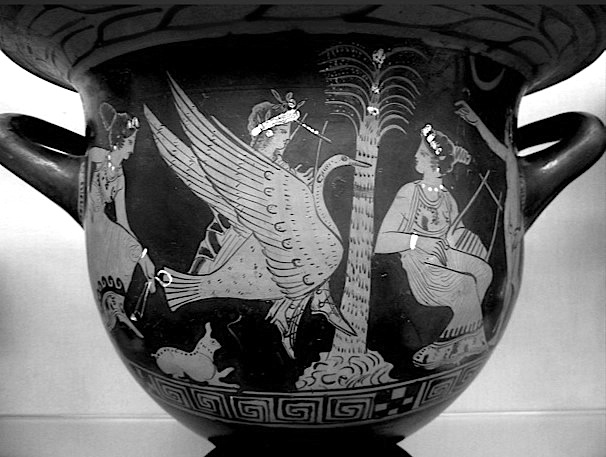
Figure
3. Greek crater cup in the British Museum showing Apollo with his lyre riding
the swan with Muses either side of him.
Swan
Song
Pythagoras, we are told, had much to say about swans, stating that "their souls were immortal, and how before their death, they rejoice and sing as going to a better life."(12) Various classical writers attested to the so-called death song of the swan, from which we derive the term swan song for a person's final great act before their death. In actuality swans do not emit any unusual sounds at the moment of death. However, it was a belief, as Pythagoras himself noted, that related very closely to their role as psychopomp carrying the souls of the deceased toward a northerly placed heaven, most obviously one located in the direction of the Cygnus constellation and northern celestial pole. It is a connection that confirms still further the association between music, swans and the area of the night sky occupied by the Summer Triangle, arguably the original form of the lyre of Apollo and Orpheus, which features in polarcentric cosmological ideas through the fact that the northern celestial pole passes through this area of the sky during its 26,000-year precessional cycle.
Maeonian
Pactolus
Somehow
there existed, whether meaningful or otherwise, a direct link between the origin
of the seven-note scale and the swan in its role as the so-called "bird of
the Muses." The key to this enigma is understanding why exactly the swans
that heralded the birth of Apollo are said to have left behind "Maionian
Paktolos."
"Paktolos," otherwise spelt Pactolus (modern Sart Çay), is a river in southwest Anatolia. It rises on the slopes of Mount Tmolus (modern Bozda dagh, and see fig. 4), which in the age of Homer, ca. 750 BCE, was located in the Bronze Age kingdom of MAIONIA more usually translated as Maeonia, Maeoniae or, more simply, Meonia (pronounced mae-on-iya(13)). Maeonia and its inhabitants were later absorbed into the much larger Iron Age kingdom of Lydia, which had established its capital at Sardis on the Pactolus river.
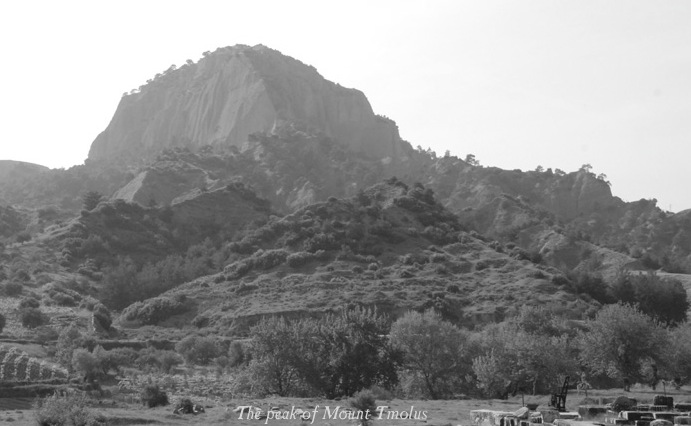
Figure
4. Mount Tmolus in southwest Anatolia. Anciently it was one of the most sacred
places in the kingdom of Maeonia.
The
Contest on Mount Tmolus
Both
the Pactolus and the Käyster (modern Küçük Menderes, "Little
Meander"), another river that takes its rise on Mount Tmolus, were celebrated
for their swans. These were found in great numbers in the meadows through which
they flowed, something noted on various occasions by ancient writers.(14) Somehow
the swan colonies of Maeonia became associated with divinely inspired creativity
including music, song, dance, as well as epic poetry. How exactly is unclear,
although it unquestionably had something to do with Mount Tmolus, which in legend
is the setting for a fatalistic musical contest between the god Apollo and the
satyr Marsyas (or Apollo and the god Pan in other versions).(15)
In
the contest (see fig. 5) Apollo played his lyre while Marsyas used a double flute
called the aulos, which had formerly belonged to the goddess Athena. She
was playing it by a lakeside when on seeing her reflection change in the water's
mirror-like surface she cast it away, believing the flute possessed (or that it
made her cheeks puffy in one account). Marsyas, passing by the spot, picked up
the flute and started playing it. Because it had previously belonged to the goddess
the flute instantly produced a host of melodic sounds unlike anything Marsyas
had heard before. This the satyr used to his advantage, gaining the upper hand
during the contest on Mount Tmolus.
Apollo
only won the day when he began to sing and play the lyre at the same time, (or
played his lyre upside down in another version), and so as punishment Marsyas
was hung from a tree and flayed alive (the winner could do what he liked with
the loser). His skin was left in a cave, and from his blood, or the tears of his
mourners in one version, came the source of the River Marsyas in neighbouring
Phrygia. Along the river flowed Marsyas's flute, which was eventually retrieved
and placed in the temple of Apollo at Sicyon in the Greek Peloponnese.
So
how might this story be of relevance to the celebrated swans of Maeonia, and their
role in determining the number of strings on Apollo's lyre? The answer is that
while the judge of the contest was the mountain-god Tmolus, the genius locus or
spirit of the mountain, the umpires were the Muses. Presumably this was due to
the presence locally of the Maeonian swans, although of unquestionable relevance
here is the fact that the surname of the Muses is sometimes given as Maeonidae.
Apparently, they gained this name because Homer, their greatest fan, was born
at Smyrna (modern Izmir), a city of Maeonia, located on the southwestern coast
of Asia Minor. More likely, however, is that this appellation was applied to the
nine Muses because they were seen to preside over the kingdom of Maeonia. Various
other groups of Muses - sometimes three, sometimes nine - thrived in other parts
of the Greek empire, their cultic origins no doubt deriving from the elevation
to this role of some local group of goddesses or nymphs.
Bringing
us even closer to the root behind this contest between Apollo and the satyr Marsyas
is the latter's entry in A Dictionary of Greek and Roman Biography and Mythology,
edited by William Smith and published in 1867. This proposes that the battle related
specifically to variations in different types of musical scales, each one vying
for superiority during the early classical age:
The
fable evidently refers to the struggle between the citharoedic and auloedic styles
of music, of which the former was connected with the worship of Apollo among the
Dorians, and the latter with the orgiastic rites of Cybele in Phrygia.(16)
Citharoedic is a reference to the seven-stringed lyre, while auloedic refers to the wind instrument played by Marsyas, who is said to have been the inventor of the aulos or double flute.(17) More significantly, Marsyas was not just a satyr, but also a worshipper of Dionysus; he is even identified with Dionysus's great companion Silenus.(18) In addition to this, Marsyas was a follower of Cybele and participated in the orgiastic rites conducted in her name. These rites were synonymous with the development of those connected with Bacchus-Dionysus right across Asia Minor during the Bronze Age. Marsyas and Orpheus, who is said to have introduced the mysteries of Bacchus-Dionysus to the Greek Empire, also shared the same father in Oeagrus, the king of Thrace.(19)
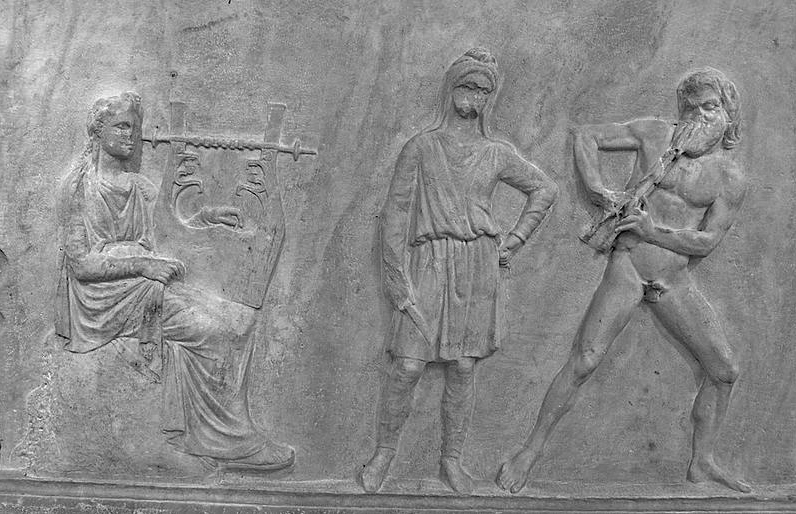
Figure
5. Greek stele showing the musical contest between Apollo with his lyre (left)
and Marsyas with his aulos (right), which took place on Mount Tmolus. The figure
in the centre is probably the mountain god Tmolus, who acted as judge. From the
base of a sculpture dated to 350-320 BCE from Mantineia. an ancient city in Arcadia.
Neolithic
Origins
Neolithic settlement sites such as Ulucak Höyük, located on the banks of the River Hermus (modern Gediz çay), into which the River Pactolus flows, and other similarly aged sites in the vicinity of ancient Ephesus, are thought to have been part of a westward migration of the sedentary lifestyle that began at key urban centers such as Catalhöyük and Hacilar in central Anatolia, ca. 7000-5500 BCE. The occupational mound of Ulucak Höyük is located immediately to the south of Mount Spil (Spil Dagh). This was the Mount Sipylus of Greek mythology, close to which was the site of Sipylus or Tantalis, the ancient capital of Maeonia. Mount Sipylus was sacred to the Great Mother Cybele whose origins might be looked for in the striking mother goddess statues found at both Catalhöyük and Hacilar.
The
emergence of the Pottery Neolithic age in Anatolia saw the spread westwards of
new technologies, including the processes involved in the fermentation of grapes
to create wine, the mainstay of the rites of Bacchus-Dionysus and those of the
goddess Cybele. It is thus surely no coincidence that Maeonia's Käyster valley
was once celebrated as a wine-producing region.(20) Not only were the slopes of
Mount Tmolus famous for their vineyards,(21) but on its heights the Lydian bacchantes
are said to have conducted their orgiastic rites.(22)
The
contest between Apollo and Marsyas appears to record a metaphorical struggle for
superiority between two rival factions, perhaps priesthoods, tribal groups or
mystery schools. One venerated Apollo and the Muses, and employed the use of the
seven-stringed lyre, while the other venerated Dionysus and Cybele, the so-called
Mother of the Gods (there was a temple of Cybele on the Pactolus river, not far
from Tmolus(23)). This second faction would seem to have favoured the use of the
much older, more archiac flute, sacred to the goddess Athena. Who these rival
groups might have been will probably never be known, although the former, allied
to Apollo, was quite clearly the victor, while the latter - whose roots could
well have gone back as far as the Neolithic age - was the loser. The greater outcome
of this conflict was the ascendancy of the cult of Apollo, while that of Bacchus-Dionysus
would be left to flourish elsewhere in the Greek and Roman world.
Orpheus
the Uniter
Yet
in the figure of Orpheus (see fig. 6), these two separate traditions, that of
Apollo and the Muses and that of Bacchus/Dionysus/Cybele, would become blurred.
We can see this from the fact that Orpheus was, on the one hand, considered Apollo's
son and inheritor of his lyre, while on the other he was the disseminator of the
mysteries of Bacchus-Dionysus, even though he is eventually torn to pieces by
the Maenads during one of their wild orgiastic rites. Very clearly the rites of
Apollo were based on a quite separate tradition, one presumably without such frenzied
antics! Instead, divine inspiration was acquired via the intervention and invocation
of the Muses, whose symbol was the swan.
It
was, of course, the swan that Orpheus's soul became at the point of death, although
how this was known is not made clear. Can we see here a subtle dig at the cult
of Bacchus-Dionysus in Orpheus not becoming a panther, the god's principal totem,
in death? Maybe so, although when during the latter stages of the Roman Empire,
ca. 300-400 BCE, the mystery schools of Orpheus spread across Europe, shrine rooms
set aside for his worship would often contain mosaics showing the poet playing
his lyre with the leopard-panthers of Dionysus close by(24) (the panther was also
a totem of Apollo, see fig. 2). Both creatures, the swan and the panther, were,
like Orpheus himself, personified in the night sky as the constellation of Cygnus
(for more on this subject see The Cygnus Key
by the current author).
The contest between Apollo and Marsyas and the account left to us by Callimachus of the nine swans that circled around the island of Delos at the birth of Apollo, show us that the ancient kingdom of Maeonia, and Mount Tmolus in particular, played a crucial role in the emergence of the swan as a symbol of music, song, poetry and dance. Yet as we shall see next, the importance of Mount Tmolus goes far beyond its role as the source of the rivers celebrated for their swans, for there is compelling evidence that the mountain was seen as the true source of the Muses' divine inspiration.
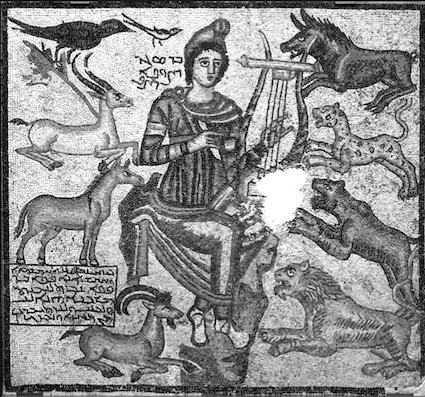
Figure
6. Syrian period mosaic found at Sanliurfa in southeast Anatolia showing Orpheus
using the lyre of Apollo to charm the creatures of the natural world.
Apollo versus
Dionysus
Mount
Tmolus was very clearly at the root of the struggles between two different rival
groups or factions that vied for superiority regarding the manner in which divine
inspiration created through music, song and dance was to be disseminated among
the ancient peoples of Asia Minor. The victor was the cult of Apollo, the god
of music, with his symbol of the swan. The loser, the orgiastic cult of Dionysus,
had to continue its own rise in popularity elsewhere in the ancient world.
Yet
beyond the rivalries of Apollo and Dionysus was perhaps a far more archaic tradition,
one to which the cults of Apollo and Dionysus might have looked toward for inspiration
in their own beliefs and practices. More importantly, this much earlier tradition
had probably passed through Neolithic cult centers such as Catal Hoyuk and Hacilar
several thousand years earlier. Furthermore, and as we shall see, its existence
might well help explain why the Muses bore the surname Maeonidae. Our initial
clue is in the name of one of Tmolus's peaks, which is today known as Kisilja
Musa Dagh,(25) Kisilja Mousa Dagh(26) or even simply Musa Dagh.(27)
Dagh
in Turkish means "mountain," while Kisilja (also written Kizil-djeh(28))
derives from the Turkish kizil, meaning "red," an allusion no
doubt to the redness of the mountain's bedrock. Musa or Mousa can only be a reference
to the Muses (Greek Moûsa), especially since they were present on Mount
Tmolus as umpires during the contest between Apollo and Marsyas. Their connection
with this ancient holy mountain is tantalizing, especially as the Greek word Moûsa
expresses the concept of divinely inspired knowledge and wisdom obtained through
music, song and dance. So was the genius loci or spirit of Mount Tmolus
seen as being able to bring forth the inspiration of the Muses?
In
some stories the Muses are associated very specifically with springs and fountains;
they are even said to have been born from the gushing waters of sacred springs
brought forth by the winged horse Pegasus on Mount Helicon in Greece. I was intrigued
therefore to find that Mount Tmolus possesses hot sulphur springs that rise from
the bed of a mountain stream at the base of the slope on its northern side. Moreover,
I discovered that these water sources are thought to have been important to the
earliest inhabitants of the region.(29) The localities of these springs, the waters
of which reach temperatures in the range of 100º to 130º Fahrenheit
(38-54º Celsius), are indicated, according to one travel report from the
nineteenth century, by the "vapour which hangs over the surface."(30)
At some point the main spring was incorporated into a Turkish bath-house (hammam).
Crowds would descend on the site in all seasons looking to cure all types of malady
and disease.(31) Strangely, the hot springs were said to be where "gods gave
life to the dead."(32)
The
Goddess of Tmolus
Before
the kingdom of Maeonia was absorbed into that of Lydia, Mount Tmolus would appear
to have been sacred to a goddess named Meter Hipta, "Mother Hipta,"
who was a localized form of the Hurrian and Hittite goddess Hepat or Hebat.(33)
Hipta (also spelt Ipta, Hippa or Ippa) was an earth mother and chthonic deity
who later became synonymous with the Magna Mater (Great Mother) Cybele, and her
Cretan counterpart, the cave mother Rhea.(34) Paintings and carved representations
of the Hurrian goddess Hepat show her standing on a lion or panther (almost certainly
the latter),(35) indicating perhaps that Hipta owes her origin, like Cybele, Hepat
and even Rhea, to the ancestry goddess represented by the full-bodied female statues
accompanied by leopards found at Catal Hoyuk and Hacilar in central Anatolia.
Hipta
was said to have been the nurse of Bacchus-Dionysus,(36) or Sabazius, the name
by which he was known in Lydia and neighbouring Phrygia.(37) Having been released
from the thigh of Zeus, following the death of his mother Semele, Hipta placed
the child on her head within a red líknon, a winnowing basket, around which
wound a dragon(38) or snake.(39) This strange headdress conjures to mind the reddish
appearance of Mount Tmolus,(40) which probably gave rise to its name Kizilja Mousa
Dagh (Red-like Muses mountain). If correct then it makes sense of the claim in
one Orphic hymn that Hipta dwelt "in Tmolus,"(41) in other words only
her red líknon headdress could be seen above ground as this jutting mountain
summit.
At
Mount Tmolus Hipta would have been associated not just with its caves and river
sources, but also with its hot sulphur springs, their vapors perhaps inducing
divine inspiration like the mysterious vapors that are said to have risen from
a chasm in the rock at Delphi in Greece. This would explain why the springs were
where the "gods gave life to the dead," since the intoxicating effects
of the vapors, along with the primal setting of the mountaintop, might well have
induced supernatural experiences in which communion with ancestral spirits became
possible.
The
springs on Mount Tmolus and Mount Ida in neighbouring Phrygia were associated
directly with Cybele in her role as the Mountain Mother, or Mother of the Gods.(42)
Yet because her cult almost certainly absorbed that of Hipta in Maeonia, there
is every reason to conclude that Hipta, and not Cybele, was the original Mountain
Mother of Tmolus. Proclus in the fifth century AD records that Ippa, i.e. Hipta,
"hastens to the Mother of the Gods, and to Mount Ida, from which all the
series of souls is derived."(43). Since Proclus mentions Tmolus and Ida together
in connection with Hipta, then it seems likely that his allusion to the "Mother
of the Gods" refers not simply to Cybele, but to Tmolus in its role as a
personified form of Hipta in her role as Mountain Mother.
The
Swan Goddess of Ephesus
No
representations of the goddess Hipta have so far been identified. For this reason
we have no real knowledge of her symbols or animal totems, other than the dragon
or snake said to wind around the winnowing basket she places on her head. However,
the Altes Museum in Berlin has in its possession an ivory statue (see fig. 7)
of a woman, most likely a goddess, that was acquired at Ephesus, the celebrated
Greek city on the southwest coast of Anatolia.(44) She wears a floor-length robe,
its vertical folds running the entire length of her body, as well as a headdress
identified as a form of polos. These were tall cylindrical hats worn by Anatolian
women from the Hittite period through to the classical age. The woman stands on
a winged sphinx, its female head of unquestionable Egyptian appearance, while
from the top of her head emerges the neck and head of a swan. At 22.5 centimetres
in height, this extraordinary figurine identified as a "swan goddess"(45)
is thought to have formed the side handle of a kithara, a type of lyre, the swan's
head having contained the crossbar to which the strings were attached.
The artistic style of the Ephesian swan goddess is similar to other ivory figurines found in a funerary hoard retrieved from Tumulus D at Elmali near Antalya on the south coast of Anatolia. Since this mound dates to ca. 750 BCE,(46) we can be pretty certain the ivory piece from Ephesus dates to the same period, and shares a common origin. It has been proposed that the carved female form is that of a mother goddess, perhaps Cybele.(47) This would link Cybele not only with the symbol of the swan, but also with the lyre or kithara. Yet in the legend of the musical contest between Apollo and Marsyas on Mount Tmolus, along with the powerful connection between music, the Muses and the swans of the Pactolus river, one cannot help but suspect that the swan goddess in question is Meter Hipta, her cult having been absorbed by that of Cybele in Maeonia. Ephesus lies close to the mouth of the Cäyster river, which is just 115 kilometres away from Mount Tmolus, making this solution even more plausible. What is more, the Cäyster, like the Pactolus, was celebrated for its swans (see note 14).
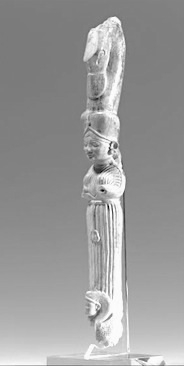
Figure
7. The so-called "swan goddess" of Ephesus currently on display in Berlin's
Altes Museum. Is this a representation of the goddess Hipta, or Ippa, the genius
loci of Mount Tmolus in Maeonia?
Soul
of the Universe
If
the Ephesian swan goddess is indeed Hipta, this would be a stunning discovery
since the Greek Neoplatonist Proclus, in his commentary on the Timaeus of Plato,
identifies Ippa, that is Hipta, as the "soul of the universe", in other
words Plato's concept of the Psyche tou Kosmouor, the World Soul:
For
Ippa who is the soul of the universe, and is thus called by the theologist [that
is, Orpheus], perhaps because her intellectual conceptions are essentialized in
the most vigorous motions, or perhaps on account of the most rapid lation [i.e.,
locomotion] of the universe, of which she is the cause … (48)
As
the intelligent creative force behind the animation of matter in the physical
world, the World Soul can be seen as a prototype of the modern conception of Gaia,
a thinking, living earth. It determined also the turning of the stars, and thus
was responsible for their emission of the so-called music of the spheres, the
inaudible sound they produce according to the teachings of Pythagoras in the sixth
century BCE, and later by Plato in the fourth century BCE.
Although
imperceptible to humanity, the World Soul could be understood, so Plato wrote,
through numeration with its presence made manifest by the proportions making up
the musical intervals found in connection with the seven-note musical scale. These
were best expressed in the tones produced by musical instruments such as the heptachord,
kithara and, of course, the lyre, given originally by the god Apollo to Orpheus
and later reinvented by Pythagoras.(49)
It
is surely no coincidence that the lyre of Apollo was connected not only with Maeonia's
Mount Tmolus, but also with the nine swans of Maeonian Pactolus, the so-called
"birds of the Muses," whose seven circuits of Delos at the birth of
Apollo are said to have determined the number of strings to be strung on the lyre.
It is this realization that shows there is a link between the invention of the
seven-note musical scale and the divine inspiration brought to poets, musicians,
artists, playwrights and even scientists, through the invocation and intervention
of the Muses. Indeed, the clear association between the Muses and Mount Tmolus
suggests that in addition to being a representation of the goddess Hipta, Ephesus's
swan goddess might well have been seen as a Muse, a nymph or goddess of inspiration.
A
Poet's Soul
The
connection between the World Soul, the Muses and divine inspiration in the liberal
arts and sciences was something that remained important beyond even the Neoplatonists
of the classical age. The Italian scholar, Catholic priest and humanist Marsilio
Ficino (1433-1499) was one of the most important philosophers of the medieval
renaissance. He dedicated much of his life to creating Latin translations and
commentaries of all major works of Plato. He proposed that the Muses "take
hold of a poet's soul"(50) creating a poetic frenzy, an inspired state based
on Plato's concept of four types of mania: the poetic, the musical, the telestic
(i.e., magical or wondrous) and the prophetic, all of which were considered to
be, quite literally, "possession or inspiration from the Gods."(51)
Although this mania was thought to be caused through the intervention of "the
nymphs," i.e. the Muses, there were other sources of divine possession such
as that "from Pan, from the mother of the Gods [i.e., Cybele or Hipta], and
the Corybantes [Phrygian dancers and followers of the goddess Cybele]."(52)
Was it a form of "mania" that took place on Maeonia's Mount Tmolus in
the name of Hipta, Cybele and the Muses? Did this "possession or inspiration
from the Gods" occur in association with its caves and hot sulphur springs?
Ficino
believed that through poetic frenzy an inspired person could rise up toward the
higher spheres and join with the World Soul, our individual souls being small
fragments of the original divine soul that have become separated and trapped inside
our bodies. It was a concept based on the story that, after killing and eating
Dionysus, Zeus incinerated the Titans. From their charred remains the sky god
fashioned mortal kind, meaning that inside every living person there is a tiny
piece of the original divine soul of Bacchus-Dionysus.
In addition to the spread of Neo-Platonism during the European renaissance of the fifteenth and sixteenth centuries, both the swan and the name Maeonia, or Meonia, became notable mnemonic devices alluding to the importance of divine inspiration in the liberal arts and sciences. These are matters we should point out that were often at loggerheads with the teachings of the Catholic Church.
Sir Philip and Lady Mary Sidney
Elizabethan poets and patrons of the arts Sir Philip Sidney (1554-86) and his sister Lady Mary Sidney (1561-1621), for example, adopted the swan as a symbol denoting the inspiration of the Muses. Their use of the swan in this manner was itself inspired by the phonetic play on words between their surname, Sidney, and cygne, the Latin and French word for swan. In one engraving of Mary known as the "Swan Picture," swans can clearly be seen embroidered into her neck collar. She herself was either named or alluded to as a Muse in her role as patron of poets, or as a writer and poet in her own right. Mary Sidney was compared also to Helen of Troy who in Greek mythology was said to have been born from an egg laid by Leda after Zeus in the form of a swan had impregnated her.
Lady Mary's
home at Wilton in the English county of Wiltshire was a virtual academy for freethinkers,
playwrights, and poets, as well as those who practised the more liberal arts such
as alchemy and Hermetica. Unquestionably, the swan, as a symbol of the Muses,
was important to this circle. William Shakespeare (1564-1616) was a regular visitor
to Wilton, and it is thought that at least two of his plays were first performed
there. Also of note is that the title of a collection of poems by the Elizabethan
poet Robert Southwell (1561-95) was entitled Maeoniae, or certain excellent
Poems and spirituall Hymnes, etc. (1595). Southwell was a Jesuit priest put
to death for his adherence to the Catholic cause. His collection of poems was
published posthumously by printer John Busby, so the name Maeoniae as a
choice for the title was probably not that of Southwell. John Busby is forever
linked in name with the dubious publication of three of Shakespeare's "bad"
plays (Henry V, 1600; The Merry Wives of Windsor, 1602, and King
Lear, 1608). Very clearly Busby understood the potency of the name Maeonia
as a symbol of the inspiration of the Muses, which in this instance referred to
the apparently inspired poetry of Robert Southwell.
In
the classical age major poets had been given epithets alluding to the swan being
a vehicle of the divine inspiration of the Muses. Homer (ca. 950 BCE), for instance,
was known as the Swan of the Meander. Pindar was the Dircaean swan, while the
Roman poet Virgil (70-29 BCE) was the Swan of Mantua. Orpheus, the first poet,
had himself become a swan in death. That after his translation Orpheus was transformed
into the constellation of Cygnus led artists and poets of the renaissance era
to believe that in death their soul might also make its way to the celestial swan.(53)
It was in this spirit that the English playwright, poet and actor Ben Jonson (1572-1637)
wrote a moving eulogy to William Shakespeare following his death. It appeared
in the First Folio of his collected plays published in 1623 and included the following,
rather curious lines:
Sweet
swan of Avon! what a sight it were
To see thee in our waters yet appeare,
And
make those flights upon the bankes of Thames,
That so did take Eliza, and our
James!
But stay, I see thee in the Hemisphere
Advanc'd, and made a Constellation
there!
Shine forth, thou Starre of Poets, and with rage,
Or influence, chide,
or cheere the dropping Stage;(54)
Through Jonson's use of the term
"Sweet swan of Avon," an allusion not to actual swans, but swans of
inspiration, Shakespeare is here being linked, as one critic put it, "with
the 'Swans' of Dirce, Maeonia and Mantua-Pindar, Vergil and Homer-and thus making
a huge claim for him as the maker of English, and the National Poet."(55)
More significantly, Jonson's allusion to "a constellation there" and the "Starre of poets" can only be an allusion to the celestial swan, in other words Cygnus, as the source of this divine inspiration.(56) More particularly it is a reference to the star Deneb, which features, rather mysteriously, in Shakespeare's "Hamlet." Indeed, Shakespeare deliberately featured the star in the knowledge that the play would first be viewed by a public audience during a specific window of opportunity that fell between October 30th and November 10th, 1601.(57) Most likely the date chosen was either All Hallow's Eve, October 31st; All Saint's Day, November 1st, or All Soul's Day, November 2nd, all dates fitting for Old Hamlet's Ghost to walk the night. On all these days, around midnight to one o'clock in the morning, Cygnus in its role as the Cross of Calvary stood upright immediately above the northwest horizon.
New Age of Enlightenment
A major clue behind the resurgence of interest in the "Sweet Swan" and the name Maeonia as symbols of both the nine Muses and their inspiration in bringing forth the liberal arts and sciences was the appearance in the year 1600 of a stella nova, a new star, in the constellation of Cygnus. It is today known as P Cygni and is located at the base of the neck of the celestial swan (see fig. 8). News of such a marvel appearing in the heavens at the dawn of the seventeenth century is very likely to have galvanized those looking towards uniting the religious divisions of Catholics and Protestants through the arts and sciences into believing that their cause was not only valid but also divinely inspired. It could even have led to them adopting both the symbol of the swan and the name Maeonia as hidden expressions of their cause. This is likely to have included mystical philosophies based on the growing interest in alternative religious ideals such as the Egyptian-inspired Hermetica introduced to England by Giodarno Bruno (1548-1600) during his extended visit to the country in 1583-5.(58) The hermetic philosophy had it roots in the translation of Arab hermetic texts by Marsilio Ficino under the patronage of the de Medici family at the end of the fifteenth century. The fact also that Bruno died in 1600, the year of the nova in Cygnus, is also going to have been seen as an omen of change by clandestine circles revolving around the liberal arts and sciences, such as the semi mythical School of Night alluded to by Shakespeare in his play Love's Labour's Lost and thought to have included a number of freethinkers of the day.
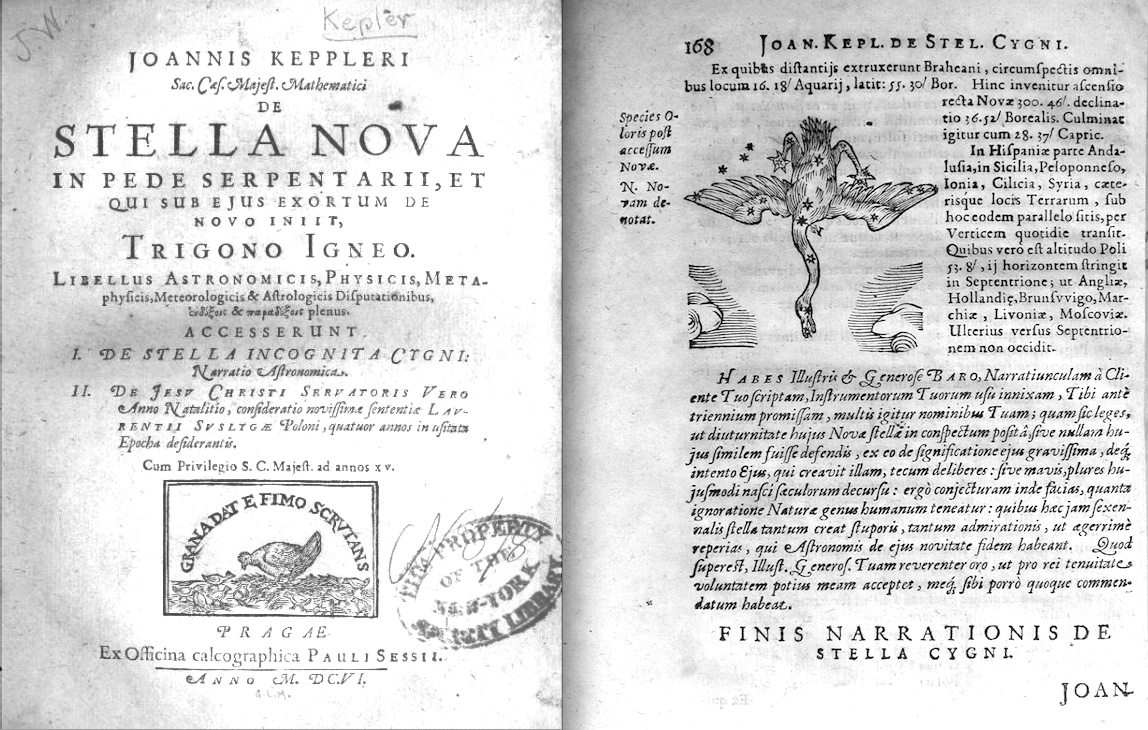
Figure
8. Left, frontispiece from Johannes Kepler's book of 1606 on the stellar nova
seen in Serpens in the year 1604 and in Cygnus in 1600. Right, a page from the
same book with a woodcut showing the new star in Cygnus located at the base of
the swan's neck. Next to it appears the letter "N.".
Since 1600 additionally marked the assumed culmination of the Elizabethan period there was much anticipation concerning a coming age of enlightenment. Yet as history tells us, under the strict rule of James I, and later the Commonwealth of Oliver Cromwell, this new age would remain underground until the Restoration of the monarchy under King Charles II in 1660 and the eventual flowering of the arts and sciences following the foundation of the Royal Society that same year. Those who carried the flame of enlightenment in Britain and mainland Europe during the intervening years were the supposed members of a mysterious organization known as the Fraternity of the Rose Cross, better known as the Rosicrucians. They unquestionably saw the appearance of the new star in Cygnus - as well as another four years later in Ophiuchus, the serpent bearer - as a celestial sign marking the emergence into the open of the liberal arts and sciences. This is made clear by various references to these stars in contemporary Rosicrucian-inspired literature and illustrations (see fig. 9).(59)
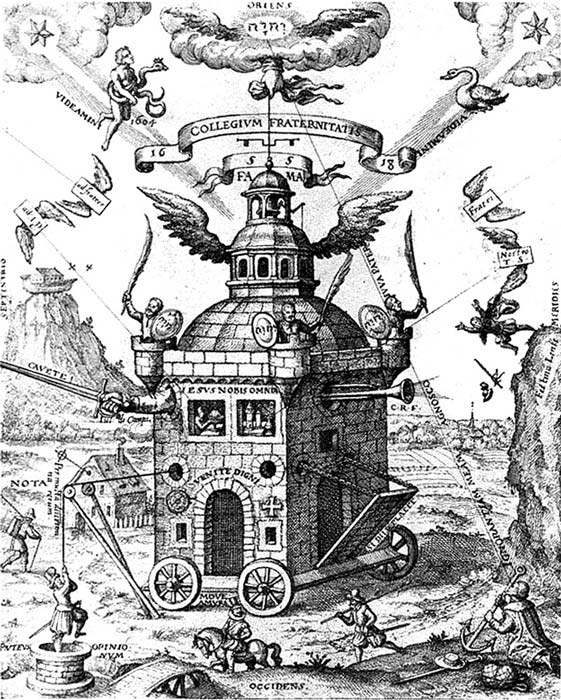
Figure
9. Allegorical illustration from 1618 showing the Rosicrucian's Invisible College
in its role as a bastion of free thinking in the arts and sciences. The new stars
in Serpens in 1604 (upper left) and Cygnus in 1600 (upper right) are pictured
as being major influences on the movement at this time.
Thus
we can see that some of the key mystical symbols of the Elizabethan age were derived
from a continued memory of the importance of the nine Muses and swans of Maeonia
in the dissemination of the liberal arts and sciences. However, in Elizabethan
England the Nine Muses of Arts and Learning ceased to be seen in terms of female
nymphs but were instead portrayed as nine "worthies" of history and
fable. These were made up of three "Pagans," usually Hector, Alexander
and Julius Ceasar; three Christian heroes, usually King Arthur, Charlemagne, and
Godfrey de Bouillon, and three heroes of Scripture, usually Joshua, David, and
Judas Maccabaeus. In this manner the power and influence of the Muses, with their
symbolic associations with both the constellation of Cygnus and the nine swans
of Maeonia, inspired the foundation of the age of enlightenment.
Final Thoughts for those Familiar with the Green Stone Story
On October 21st, 1979, writer Graham Phillips and the current author found a short steel sword with the inscription "Meonia fore Marye" on its blade by the side of a footbridge at the Knights Hill Pool near Seven Stoke in Worcestershire, England (see fig. 10). The sword had been placed in a small earthen cavity behind a dry-stone wall shoring up the side of the lake. This earthen cavity was located exactly nine stones along from the bridge and nine stones down from the top of the wall. Nine as a number had become important following the discovery of a North Worthies wall mural in nearby Harvington Hall, near Kidderminster in the West Midlands. The wall mural dates to the end of the Elizabethan age and had almost certainly been commissioned by its owner Sir Humphrey Packington, a noted Catholic Recusant. One of the Nine Worthies, David the giant killer, shows him holding a sword above his head in a defensive stance known as the St George's Parry. Nine, as we now know, is the number not only of the Nine Muses of Arts and Learning, but also of their vehicles, the nine swans of Maeonia, or "Meonia" as it was also spelt at this time.
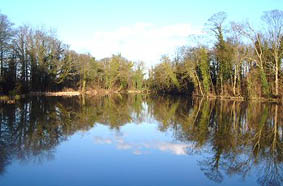
Figure
10. The Knights Hill Pool where the "Meonia fore Marye" sword was found
in 1979.
Knowledge
of the stella nova seen in Cygnus in the year 1600 alerted Graham Phillips and
the author to the existence of a bend on the River Avon near Eckington in Worcestershire
called the Swan's Neck. From the summit of nearby Breedon Hill, when the river
overflows around January-February each year, the flooded fields combine with the
Swan's Neck to create the impression of a swan on the landscape. It was on the
nape of the swan's neck, the same position that the new star appeared in Cygnus
in 1600, that Graham retrieved a brass casket later identified as being of late
seventeenth century manufacture. This was found to contain a small green stone
thought to have mythical origins.
Mr
W. G. Lee's Letter
According
to a letter written on November 15th, 1982 to a local newspaper by Mr. W.G. Lee
of Nafford Farm (see fig. 11), which is situated at the base of Breedon Hill close
to the Swan's Neck, Harvington Hall is where a legendary Green Stone was thought
to have been kept hidden during the life time of Humphrey Packington's daughter,
Lady Mary Yate. She was patron of the Jesuit priest Father John Wall (1620-1679),
who is said in the letter to have been martyred for not revealing the whereabouts
of the precious stone, even though he is not specifically named. Mr. Lee was interviewed
by the author and a colleague to confirm his claim was authentic. Any thought
that the story was derived from modern sources was quickly dispelled when it was
realized that Mr. Lee was not only an octogenarian, but was also quite blind.
The story regarding the existence of the Green Stone had been given to him by
his father when just a boy. Indeed, Mr Lee told us that as a youth he would work
with his father in the field that abuts the Swan's Neck on its southern side,
even though the family was unaware of any connection between this bend on the
River Avon and the Green Stone.
Interestingly,
from the perspective of Woollas Hall, an Elizabethan manor house standing on the
northern slope of Breedon Hill, the constellation of Cygnus can be seen to stand
immediately above the Swan's Neck around midnight to one o'clock around the beginning
of November each year. This recalls Shakespeare's allusion to the Cygnus star
Deneb in Hamlet and the fact that his plan was to first show the play around
the beginning of November 1601. In its present form, Woollas Hall dates to 1611.
It was at the time the residence of John Hanford, whose friend, the lawyer Thomas
Russell (1570-1634), was a close confident of William Shakespeare and one of the
overseers of his will.(60) Russell was also a neighbour and benefactor of the
Hanford family. Curiously, John Hanford's crest was a silver star on a black background,
which can be seen on his funerary monument in nearby Eckington church (he died
in 1616).
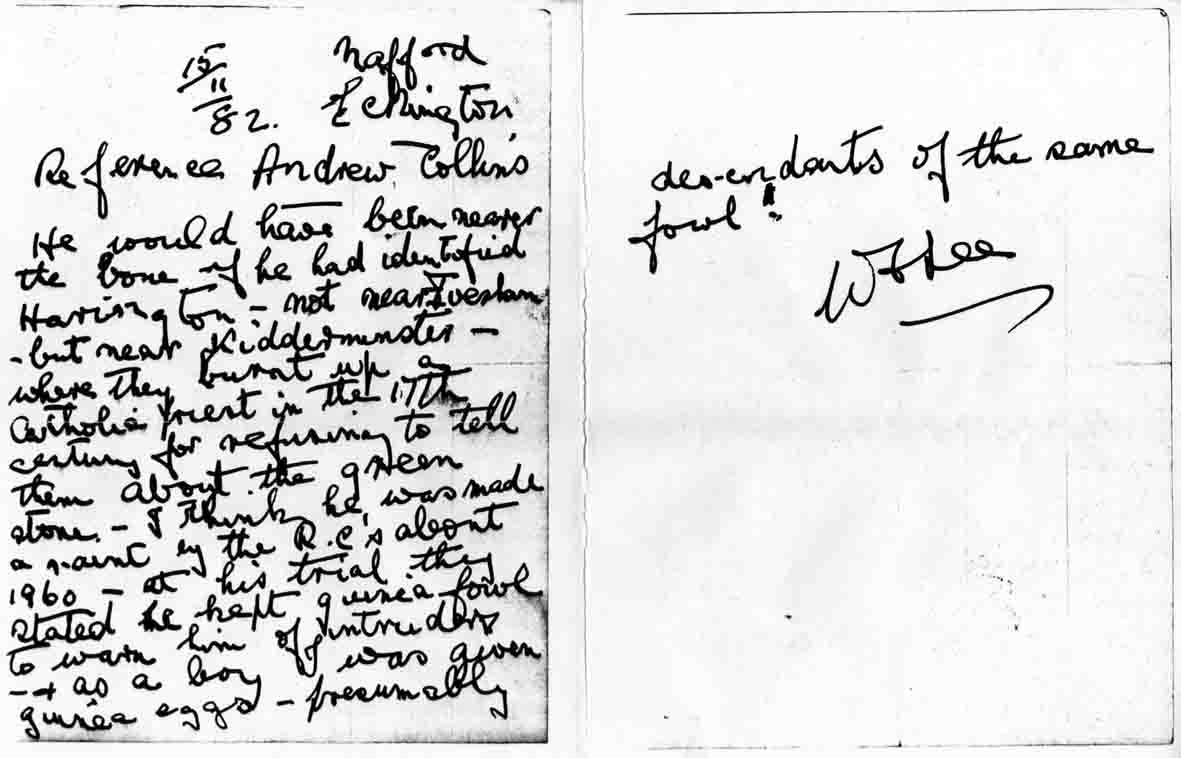
Figure
11. Letter dated November 11, 1982, from W. G. Lee of Nafford Farm sent to a local
newspaper, following the publication within its pages of a feature story about
the discovery of the Green Stone at the Swan's Neck, which lies immediately adjacent
to the farm in question.
Much
could be said about Russell's relationship to Shakespeare and his circle, although
the connection with the Green Stone story is in the fact that he purchased the
lease of Rushock Manor near Droitwich in Worcestershire.(61) It was here in 1678
that Father John Wall was captured by the Sheriff of Worcester's men.(62) The
house was owned by Thomas Russell's "well-beloved friend" Francis Finch.
Russell, who died in 1634, had bequeathed Rushock to Finch in his will.(63)
Since
Wall had been under the protection of Humphrey Packington's daughter, Lady Mary
Yate, and was said by Mr. Lee to have been martyred for not revealing the whereabouts
of the Green Stone, there is some suggestion here that both Thomas Russell and
John Hanford were somehow aware of the existence of this important treasure. It
is possible also that some knowledge of Father John Wall's connection with the
Green Stone remained in the vicinity of Woollas Hall and nearby Nafford Farm through
to the early years of the twentieth century when Mr. Lee learned about the Green
Stone and its connections with Harvington Hall and Father John Wall from his father.
Whether or not the Green Stone found by Graham Phillips at the Swan's Neck in 1979 is the same one alluded to by Mr. Lee in his letter from 1982 might never be known. Stories linger in the area of Nafford and Eckington regarding the final fate of the Green Stone, which some believe to be either still concealed in the landscape or guarded by a local family.
The
Meonia Sword
The
sword found at the Knights Hill Pool in 1979 is cast in a decorative style popular
in England during the 1590s. Certainly, the sword's inscription, "Meonia
fore Marye," is consistent with English spelling from this period. The wording
appears to imply that "Meonia," as a symbol perhaps of both the Muses
and the swans of Maeonia, existed before, or prior to, "Marye." As to
which Mary is being referred to here is unclear. It could be a reference to Lady
Mary Sidney as a Muse and patron of poetry. On the other hand, it could be a reference
to either Mary Queen of Scots or the Virgin Mary. These were the most prominent
Marys in Elizabethan thought during the second half of the sixteenth century.
Who
created the Meonia Sword, and how it came to be located by the side of a footbridge
in Worcestershire in the Midlands of England, remains a matter of speculation.
However, there seems little question that its story revolves around those who
subscribed to a coming age of enlightenment that would begin with the dissemination
of the liberal arts and sciences and the gradual unification of Catholic and Protestant
ideals in Jacobean England. Those involved, who shared the same goals and sympathies
as the Rosicrucians of the Continent, would appear to have seen as important certain
mnemonic devices. Among them were the symbol of the swan, the name Maeonia or
Meonia, and the number nine, as in the Nine Muses of Arts and Learning, the nine
swans of Maeonia, and the Nine Worthies.
With
a fresh understanding of the importance of the nine swans of Maeonia as vehicles
of the Muses and the Soul of the World, a sense of continuity can be seen to exist
between our historical knowledge of the Elizabethan Age, and the events that surrounded
Graham Phillips and the present author back in 1979. For more information on the
Meonia Sword and Green Stone story see Graham Phillips and Martin Keatman, The
Green Stone (Neville Spearman, St Helier, Jersey, 1983), and Andrew Collins, The
Sword and the Stone (The Supernaturalist, Wickford, Essex, 1982) and The Seventh
Sword (Century, London, 1991).
Please
note that the material in this article should be seen as an arc out from the author's
new book The Cygnus Key: The Denisovan Legacy, Göbekli Tepe and the Birth
of Egypt. Very little of it features in the book itself, which is a scholarly
work on the origins of civilization, cosmology and technology in southern Siberia.
The book does, however, contain material on Apollo, Orpheus, Bacchus-Dionysus,
the nine Muses and the importance of the symbol of the swan to music, song and
dance in classical tradition.
Acknowledgments
I want to thank Michael Tazzar for sharing his thoughts and research on the importance of Maeonia and the swan in Elizabethan tradition. Thanks also to Graham Phillips, Debbie Cartwright and Richard Ward for inspiration and ideas, and Roma Harding for line editing.
Notes and References
1.
This is onomaklyton Orphea, "Orpheus famous of name,", which features
in a fragment of text by Ibycus (see Reale and Catan, 1990, 294). This indicates
that even by the sixth century Orpheus was a popular character in Greek tradition.
2.
Diodorus Siculus, bk. 4, ch. 25:3. See also Hornung, 2001, 22, and Guthrie, 1993,
198.
3. Plato, The Republic, 620a: "'He saw the soul that had been Orpheus,'
he said, selecting the life of a swan, because from hatred of the tribe of women,
owing to his death at their hands, it was unwilling to be conceived and born of
a woman." (See Greek Texts and Translations, http://perseus.uchicago.edu/perseus-cgi/citequery3.pl?dbname=GreekTexts&query=Pl.%20Resp.%20620a&getid=1.
4.
Allen 1899, s.v. "Cygnus, the Swan," 192-98.
5. King 1722, 86.
6.
Ross 1648, 25.
7. Eschenbach, Estienne, Gesner, Hamberger, and Theophrastus
1764, 136 n. 1000 & 226 n. 33, 17. This proposal after Eschenbach et al is
cited also in Mead, 1965, 162.
8. "History of the Harp," https://www.harp.com/history-of-the-harp.htm.
9.
Callimachus, "Poem 4: To Delos," ll. 375-9. In Nisetich, 2001, 47.
10.
Callimachus, ll. 375-82.
11. Harris 1925, 377.
12. Leland, The Itinerary.
See Hearne 1769, vii.
13. This pronunciation is conjectural and idealistic,
based on the different spellings of the name and its easy usage by the English
language reader.
14. See Blumerel 1679, 49, and Arundell 1828, 327 nn. 3 &
4, for the swans of the Cäyster. See Cramer 1832, 442, and Chandler 1825,
319-20, for the celebrated swans of the Pactolus.
15. Ovid, Metamorphoses,
bk. 11, ch. 146.
16. Smith 1867, s.v. "Marsyas," http://www.perseus.tufts.edu/hopper/text?doc=Perseus:text:1999.04.0104:entry=marsyas-bio-1.
17.
Ibid.
18. Ibid.
19. Hyagnis and Olympus are also cited as fathers of the
former, while Apollo himself is the alternative father of the latter.
20. Barry
1775, 142.
21. Dodds, 1986, 70 n. 55.
22. See, for instance, Orphic Hymns,
47 & 48 (trans. Thomas Taylor), Theoi Texts Library, http://www.theoi.com/Text/OrphicHymns2.html#47.
23.
Cramer 1832, 442.
24. See, for instance, the Orpheus room at Littlecote Park,
Wiltshire. Its mosaic shows Orpheus with his lyre surrounded by the four seasons.
Nearby two leopard-panthers flank a large drinking vessel presumably containing
the wine that when consumed transformed the Maenads or Bacchantes into leopards.
See Walters and Phillips 1979, pl. 1.
25. Hammond 1878, 290.
26. Numen:
The Latin Lexicon, s.v. "Tmolius," http://latinlexicon.org/definition.php?p1=2059950.
27.
Dodds 1986, 70 n. 55.
28. Cramer 1832, 441.
29. De Kay 1833, 482-3.
30.
Ibid., 483.
31. Ibid., 484.
32. Hamblin 2010, 110.
33. Nilsson 1950,
568 n. 22.
34. Nilsson 1950, 569; Lane, 1989, 17-8.
35. Coulter and Turner
2013, s.v. "Hepat," 212.
36. HellenicGods.org, s.v. "Ippta -
Hipta," 2010, http://www.hellenicgods.org/hipta---hipta.
37.
Lane 1989, 17-8.
38. Proclus, On the Timæus of Plato, bk. II.
See Taylor 1820, vol. I, 344.
39. Nilsson 1950, 569. Leeming 1998, 171.
40.
Kisilja Mousa Dagh has been proposed to be the legendary Mount Draco, making sense
of this assertion. See Cramer 1832, 441.
41. Orpheus, Hymns, 48: trans.
Taylor, "To Ippa." http://www.sacred-texts.com/cla/hoo/hoo53.htm
http://www.theoi.com/Text/OrphicHymns2.html#48.
42.
Munn 2006, 73-5, 77.
43. Proclus, On the Timæus of Plato, bk.
II. See Taylor 1820, vol. I, 344.
44. "The Swan Goddess," Google
Arts and Culture, https://www.google.com/culturalinstitute/beta/asset/'the-swan-goddess'/2gETPGGWVmYIeg?hl=en.
45.
Ibid.
46. Ibid.
47. Ibid.
48. Proclus, On the Timæus of Plato,
bk. II. See Taylor 1820, vol. I, 344.
49. Mead 1965, 162.
50. Kenny 2014,
59.
51. Proclus, as quoted in Taylor, 1820, vol. II, 470.
52. Proclus, as
quoted in Taylor, 1820, vol. II, 471.
53. This view is made clear in Lutwack,
1994, 49.
54. Jonson, "To the memory of my beloved the author Mr William
Shakespeare and what he hath left us. Shakespeare 1623, n.p.n. See also Jonson
1838, XII, 693.
55. Moseley 2007, 77.
56. Alexander 2013, 20.
57. Sohmer
1999, 221-3.
58.
Yates 1964.
59. Yates 1972.
60.
Pogue 2006, 39.
61. Pogue 2006, 39.
62. "Blessed John Wall," Roman
Catholic Saints, http://www.roman-catholic-saints.com/blessed-john-wall.html.
63.
Last will and testament of Thomas Russell, who died died 1634, The National Archives
Prob 11/165/424, http://www.oxford-shakespeare.com/Probate/PROB_11-165-424.pdf.
Bibliography
Alexander,
Michael. 2013. Reading Shakespeare. New York: Palgrave Macmillan/Basingstoke,
Hants., UK: Macmillan.
Allen, Richard Hinckley. 1899/1963. Star Names: Their
Lore and Meaning. New York, Dover Publications.
Arundell, Francis Vyiyan
Jago. 1828. A visit to the seven churches of Asia: with an excursion into Pisidia.
London: Rodwell.
Barry, Sir Edward. 1775. Observations, historical, critical,
and medical, on the wines of the ancients: And the analogy between them and modern
wines. With general observations on the principles and qualities of water, and
in particular on those of Bath ... London: T. Cadell.
Blumerel, Joannes.
1679. Elegantiæ poeticæ in Locos comunes digestæ. Editio
novissima. Oxford: E Theatro Sheldoniano.
Callimachus, "Poem 4: To
Delos." In Nisetich, 2001.
Chandler, Richard (ed. Nicholas Revett). 1825.
Travels in Asia Minor and Greece. Oxford: Oxford University/Clarendon Press.
Coulter,
Charles Russell, and Patricia Turner. 2013. Encyclopedia of Ancient Deities.
New York/Abingdon, Oxon, UK: Routledge.
Cramer, John-Anthony. 1832. A Geographical
and Historical Description of Asia Minor with a Map: vol. 1. Oxford: Oxford
University Press.
Diodorus Siculus. 1935. Translated by C. H. Oldfather,
Library of History (Books III - VIII). Loeb Classical Library. Cambridge,
Mass.: Harvard University Press/London: Wm. Heinemann.
Dodds, Eric Robertson.
1986. Euripides Bacchae. Oxford: Oxford University Press/Clarendon Press.
Eschenbach,
Andreas Christian, Henri Estienne, Johann Matthias Gesner, Georg Christoph Hamberger,
and Theophrastus. 1764. Orpheos hapanta: Orphei Argonautica Hymni Libellus
de lapidibus et fragmenta. Lipsiae (Leipzig), Germany: Sumtibus Caspari Fritsch.
Guthrie,
W. K. C. 1935/1993. Orpheus and Greek Religion: A Study of the Orphic Movement.
Princeton, N.Y.: Princeton University Press.
Hamblin, David A. 2010. Unveiling
the Mysteries of the Last Days: Systematic Prophecy from Genesis to Revelation,
Mustang, Okla.: Tate Publishing.
Hammond, R. A. 1878. A History of the Empire
and People of Turkey and the War in the East. Toronto, Ontario: A. H. Hovey.
Harris,
J. Rendel. 1925. "Apollo's Birds," Bulletin of the John Rylands Library
9:2, 372-416.
Hearne, Thomas. 1769. The Itinerary of John Leland the Antiquary,
vol. the Fifth. Publish'd from the Original MS. In the Bodleian Library, etc.
Oxford: James Fletcher and Joseph Pote.
Hornung, Erik. 2001. The Secret
Lore of Egypt: Its Impact on the West (1999). Ithaca, N.Y./London: Cornell
Univ. Press.
Jonson, Ben. 1838. The Works of Ben Jonson with a Memoir of
his Life and Writings by Barry Cornwall. London: Edward Moxon.
Jowett,
B., (trans. and ed.). 1838. The Republic of Plato, Oxford: Oxford University
Press/Clarendon Press.
Kay, Charles de. 1898. Bird Gods: With an Accompaniment
of Decorations by George Wharton Edwards. New York: A.S. Barnes.
Kenny,
Neil. 2014. An Introduction to Sixteenth Century French Literature and Thought:
Other Times, Other Places. London/New York: Bloomsbury.
King, Dr. 1722.
An Historical Account of the Heathen Gods and Heroes, Necessary for the Understanding
of the Ancient Poets: Being an Improvement of Whatever Has Been Hitherto Written
by the Greek, Latin, French and English Authors Upon that Subject. London,
Bernard Lintot.
Lane, E. N. 1989. Corpus Cultus Iovia Sanazii (CCIS), III:
Conclusions. Leiden, The Netherlands: E. J. Brill.
Leeming, David Adams.
1998. Mythology: The Voyage of the Hero. Oxford/New York: Oxford University
Press.
Lutwack, Leonard. 1994. Birds in Literature. Gainesville, Fla.:
University Press of Florida.
Mead, G. R. S. 1896/1965. Orpheus. London:
John M. Watkins.
Moseley, C. W. R. D. 2007. English Renaissance Drama: A
Very Brief Introduction to Theatre and Theatres in Shakespeare's Time. Penrith,
Cumbria: Humanities-Ebooks.
Munn, Mark H. 2006. The Mother of the Gods,
Athens, and the Tyranny of Asia. Berkeley, Calif.: University of California
Press.
Nilsson, Martin Persson. 1950. The Minoan-Mycenaean Religion and
Its Survival in Greek Religion. New York: Biblo & Tannen Publishers.
Nisetich,
Frank J. (trans.). 2001. The Poems of Callimachus. Oxford: Oxford University
Press.
Ovid. Metamorphoses (trans. Brookes More). Book 11. http://www.theoi.com/Text/OvidMetamorphoses11.html.
Plato,
The Republic. In Jowett, 1888.
Pogue, Kate. Shakespeare's Friends.
Westport, Ct.: Greenwood Publishing, 2006.
Proclus,
On the Timæus of Plato, in Five Books. In Taylor, 1820.
Reale,
Giovanni, and John R, Caton. 1990. A History of Ancient Philosophy I: From
the Origins to Socrates. Albany, N.Y.: State University of New York Press.
Ross,
Alexander. 1648. Mystagogvs poeticvs or The Muses Interpreter Explaining The
historical Mysteries, and mystical Histories of the ancient Greek and Latine Poets.
London: Thomas Whitaker.
[Shakespeare, William,]. 1623. Mr. Willaim Shakespeares
Comedies, Histories, & Tragedies. Published according to the True Originall
Copies [First Folio]. London: Isaac Iaggard and Ed. Blount.
Smith, William.
1867. A Dictionary of Greek and Roman biography and mythology, vol. 2.
Boston, Mass.: Little Brown & Co.
Sohmer, Steve. 1999. Shakespeare's
Mystery Play: The Opening of the Globe Theatre, 1599. Manchester: Manchester
University Press.
Taylor, Thomas (trans.). 1820. The Commentaries of Proclus
on the Timæus of Plato, in five books; containing a treasury of Pythagoric
and Platonic Physiology: Two volumes. Vol. 1: London: A. J. Valpy/Vol. 2:
London: Thomas Taylor (author's publication).
Walters, Bryn, and Bernard Phillips.
1979. Archaeological Excavation in Littlecote Park, Wiltshire, 1978: First
Interim Report. Littlecote, Wiltshire: Littlecote Estate.
Yates,
Francis. 1964. Giordarno Bruno and the Hermetic Tradition. Chicago. Ill.:
University of Chicago Press.
Yates, Francis. 1972. The Rosicrucian Enlightenment.
London: Routledge & Kegan Paul.
This material is copyright Andrew Collins, 2017. No reproduction or copying without prior consent.
See also elsewhere on this website: WHAT IS MEONIA? ITS HISTORY AND ROLE IN MODERN PSYCHIC QUESTING by Andrew Collins
THE
NEW BOOK FROM ANDREW COLLINS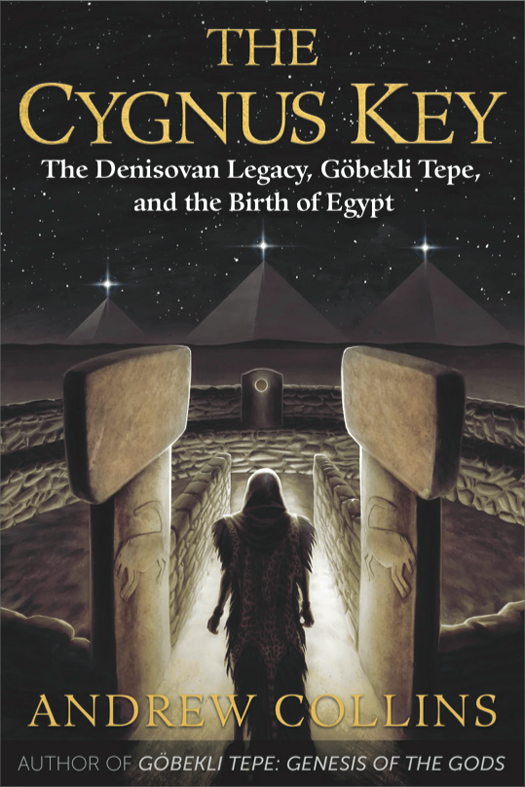
The
cover of Andrew Collins's new book The Cygnus Key: Göbekli
Tepe and the Birth of Egypt.
Cover artwork by Russell Hossain
In
the 2000s human fossil remains were unearthed in the Denisova Cave within the
Altai Mountains of southern Siberia. DNA testing showed that the bones - two molars
and a pinky bone - belonged to a previously unknown human population today known
as the Denisovans. They are now thought to have inhabited Eastern Eurasia from
around 400,000 years down to around 40,000 years ago. During their final years
the Denisovans achieved an advanced level of human behaviour, including the creation
of sophisticated symbolic or non-functional objects including an arm bracelet
in bottle-green chloritolite with a bored hole that can only have been made using
a high-speed drill; a bone needle with an eye for thread, suggesting the manufacture
of tailored clothing, as well as finely finished, pierced ostrich eggshell beads
no more than a centimetre in diameter. In addition to this, fragments of horse
bones found inside the Denisova Cave have suggested that Denisovans domesticated,
herded and maybe even rode horses long before it was thought humanly possible.
So who exactly were the Denisovans? What do we really know about them, and how
are they linked to Neanderthals and our own ancestors?
The
Cygnus Key presents compelling evidence showing that the earliest origins
of human culture, religion, and technology derive from the Denisovans, the true
creators of the lost civilization long known to exist but never before proved.
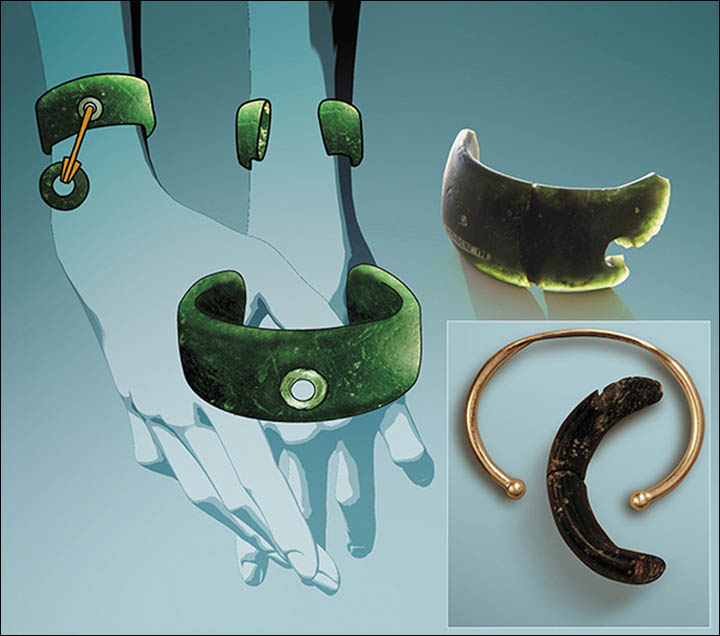
Denisovan
bracelet made of chlorite that is around 70,000 years old (credit: The Siberian
Times).
The
author explains how the stars of Cygnus coincided with the turning point of the
heavens at the moment the Denisovan legacy was handed to the first human societies
in southern Siberia some 45,000 years ago, catalyzing beliefs in swan ancestry
and an understanding of Cygnus as the source of cosmic creation. It also led to
powerful ideas involving the Milky Way’s Dark Rift, viewed as the Path of
Souls and the sky-road shamans travel to reach the sky-world. He explores how
their sound technology and ancient cosmologies were carried into the West, flowering
first at Göbekli Tepe and later in Egypt’s Nile Valley. Collins shows
how the ancient belief in Cygnus as the source of creation can also be found in
many other cultures around the world, further confirming the role played by the
Denisovan legacy in the genesis of human civilization.
Built at
the end of the last ice age around 9600 BCE, Göbekli Tepe in southeast Turkey
was designed to align with the constellation of Cygnus, the celestial swan, a
fact confirmed by the discovery at the site of a tiny bone plaque carved with
the three key stars of Cygnus. Remarkably, the three main pyramids at Giza in
Egypt, including the Great Pyramid, align with the same three stars. But where
did this ancient veneration of Cygnus come from?
Showing that Cygnus was
once seen as a portal to the sky-world, Andrew Collins reveals how, at both sites,
the attention toward this star group is linked with sound acoustics and the use
of musical intervals “discovered” thousands of years later by the Greek
mathematician Pythagoras. Collins traces these ideas as well as early advances
in human technology and cosmology back to the Altai-Sayan region of Russian Siberia,
where the Denisovans gifted humanity with the rudiments of civilization as much
as 45,000 years ago.
Publication Month: May 2018
Bear & Company.
ISBN 978-1-59143-299-9 $24.00
Paper. Also available as an ebook
Size: 464
pages, 6 5/8 x 9 1/2 inches
Includes 16-page color insert and 75 black-and-white
illustrations
Pre-order
your copy now